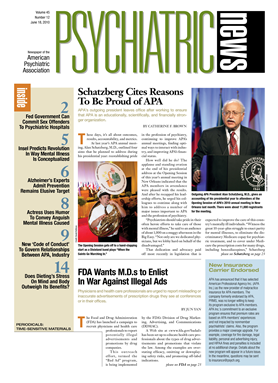Psychiatrists and other mental health advocates praised a Supreme Court decision barring certain lifetime prison sentences for people who commit crimes as minors that are unrelated to murder.
The Court's May 17 decision in Graham v. Florida held that the Eighth Amendment's ban on cruel and unusual punishment categorically bars life sentences when they come without the possibility of parole for crimes committed before age 18.
The 6-3 decision—with Chief Justice Roberts limiting his support to only this case, instead of all such cases—was hailed by mental health advocates as recognition of research evidence that juveniles are incapable of fully understanding the consequences of their actions and controlling impulsive behavior to the extent adults can.
The Court agreed with the reasoning that due to minors' lack of understanding, they should not have to sacrifice their freedom for the rest of their lives because of crimes they committed that can be influenced by their incomplete brain development.
“Juveniles differ from adults in their decision-making capacities, which can be seen in our nation's laws regarding voting, driving, access to alcoholic beverages, consent to treatment, contracting, and in the juvenile court itself,” said Louis Kraus, M.D., a member of the APA Council on Children, Adolescents, and Their Families, in a press statement.
The majority decision also echoed some aspects of the amicus brief APA and other organizations filed in the case and in its companion case, Sullivan v. Florida.
“Juveniles—including older adolescents—are less able to restrain their impulses and exercise self-control; less capable than adults of considering alternative courses of action and maturely weighing risks and rewards; and less oriented to the future and thus less capable of appreciating the consequences of their often-impulsive actions,” according to an amicus brief filed by APA and other mental health organizations. “For all those reasons, even once their general cognitive abilities approximate those of adults, juveniles are less capable than adults of mature judgment, and more likely to engage in risky, even criminal, behavior as a result of that immaturity.”
The Court decision was based on the life sentence given to Terrance Graham for a parole violation. The crime for which he had originally been convicted when he was 16 was the robbery of a restaurant during which an accomplice severely beat the manager. Graham was sentenced to a one-year jail term and three years of probation. At 17, Graham and two accomplices carried out a home-invasion robbery, for which they were tried and convicted. It was for violating his parole by committing the second crime that a judge sentenced him to life in prison without the possibility of parole.
The decision also was significant, Howard Zonana, M.D., a member of APA's Council on Psychiatry and Law, told Psychiatric News, because it marked the first time that the Court barred a given punishment for an entire class of offenders outside the confines of the death penalty. In 1988, the Court barred the death penalty for people who committed crimes before the age of 16, under the Constitution's prohibitions against cruel and unusual punishment. That ban was extended in 2005 to juveniles under age 18.
The application of the finding was significant to the justices too, with Justice Clarence Thomas—who wrote the dissent—criticizing the categorical ban on life sentences for juveniles instead of using case-by-case reversals when a sentence was disproportionate to the crime.
But the ban on juvenile life sentences when there is no chance for parole makes sense, said Zonana, because otherwise adolescents who can mature out of such behavior will lose the opportunity to prove that as adults they are able to reform their lives.
Child psychiatrist and APA Treasurer David Fassler, M.D., agreed that the elimination of such irrevocable life sentences will accommodate the individual ability of juvenile convicts to mature and improve beyond their mental capacity when they committed their crimes.
“As Justice [Anthony] Kennedy notes, these biological and developmental differences do not excuse violent or criminal behavior,” Fassler told Psychiatric News. “However, they can and should be taken into account when determining consequences or weighing the potential for future rehabilitation.”
The decision could affect laws in 37 states, the District of Columbia, and federal law, which allow life-without-parole sentences for juveniles convicted of nonhomicide offenses. Of the 129 juveniles now imprisoned with life-without-parole sentences, 77 are in Florida.
Despite most states allowing juveniles to receive these sentences, Kennedy's majority opinion also stated that the rare use of this sentencing option clearly showed that “a national consensus has developed against it.”
The majority opinion explicitly noted that it does not require states to “guarantee eventual freedom to a juvenile offender convicted of a nonhomicide crime. What the State must do, however, is give defendants like Graham some meaningful opportunity to obtain release based on demonstrated maturity and rehabilitation.”
How states pursue that “meaningful opportunity” for future review of such inmates will draw court scrutiny because it was left so vague, said Peter Ash, M.D., a member of the APA Committee on Judicial Action, in an interview with Psychiatric News.
Also left unresolved by the decision is the use of extremely long fixed sentences, which may have the same effect as life sentences. In fact, Justice Samuel Alito's separate dissent said the Court's decision would not affect such sentences.
Additionally, Zonana noted, it remains unclear whether the ruling will affect all juveniles currently serving life sentences or just those whose cases are under appeal, in addition to future cases. Furthermore, the case highlights the contentious issue of juvenile sentences in general, and advocates are expected to try to extend its logic to the more than 2,000 inmates serving life sentences where parole is not an option for participating in killings as juveniles.
